Ten months after the AMD EPYC 7002 series “Rome” launch, and almost three years after the EPYC 7001 launch, Lenovo finally has joined Dell EMC, HPE, Supermicro, and others with dual-socket AMD EPYC solutions. With the new Lenovo ThinkSystem SR665 (2U) and ThinkSystem SR645 (1U) servers, Lenovo now has dual-socket offerings to accompany the rapidly growing Chinese (with large global presence) server vendor’s EPYC lineup.
Lenovo ThinkSystem SR665
The Lenovo ThinkSystem SR665 is the company’s two socket 2U offering. It supports up to 20x 3.5″ or 40x 2.5″ drives, of which 32 can be NVMe. Lenovo is trying to differentiate this offering with massive storage. The 32 drive NVMe solution uses 64x PCIe lanes instead of a full 128 lanes. Otherwise, that would alone use all of the PCIe connectivity except for WAFL lanes on the EPYC platform.

Here are the official specs. As one can see, Lenovo is supporting up to 280W TDP CPUs which is important for the higher-end EPYC 7002 series and looking ahead to the EPYC 7003 “Milan” generation later this year.
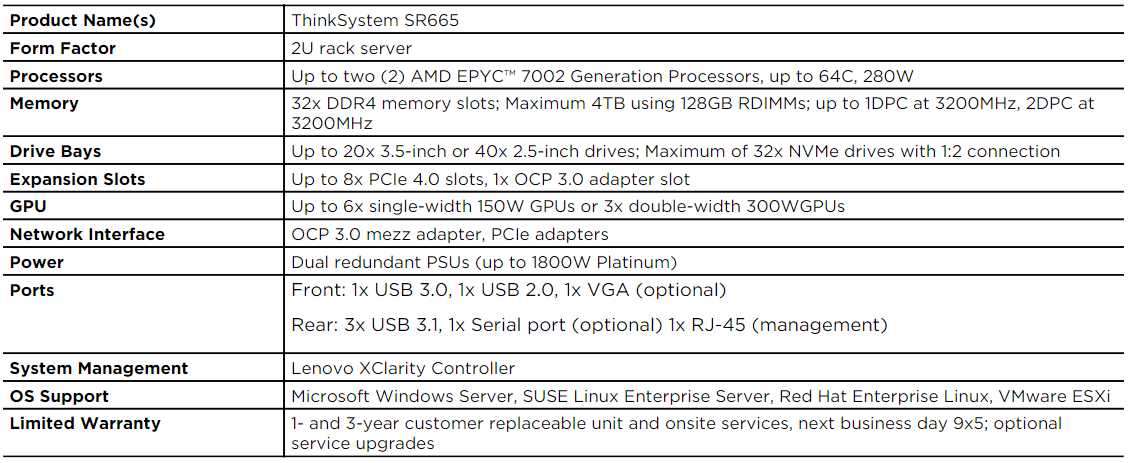
From the internal view, you can see Lenovo is adopting the OCP 3.0 NIC slot along with HPE, Dell EMC, Supermicro, and many other vendors.
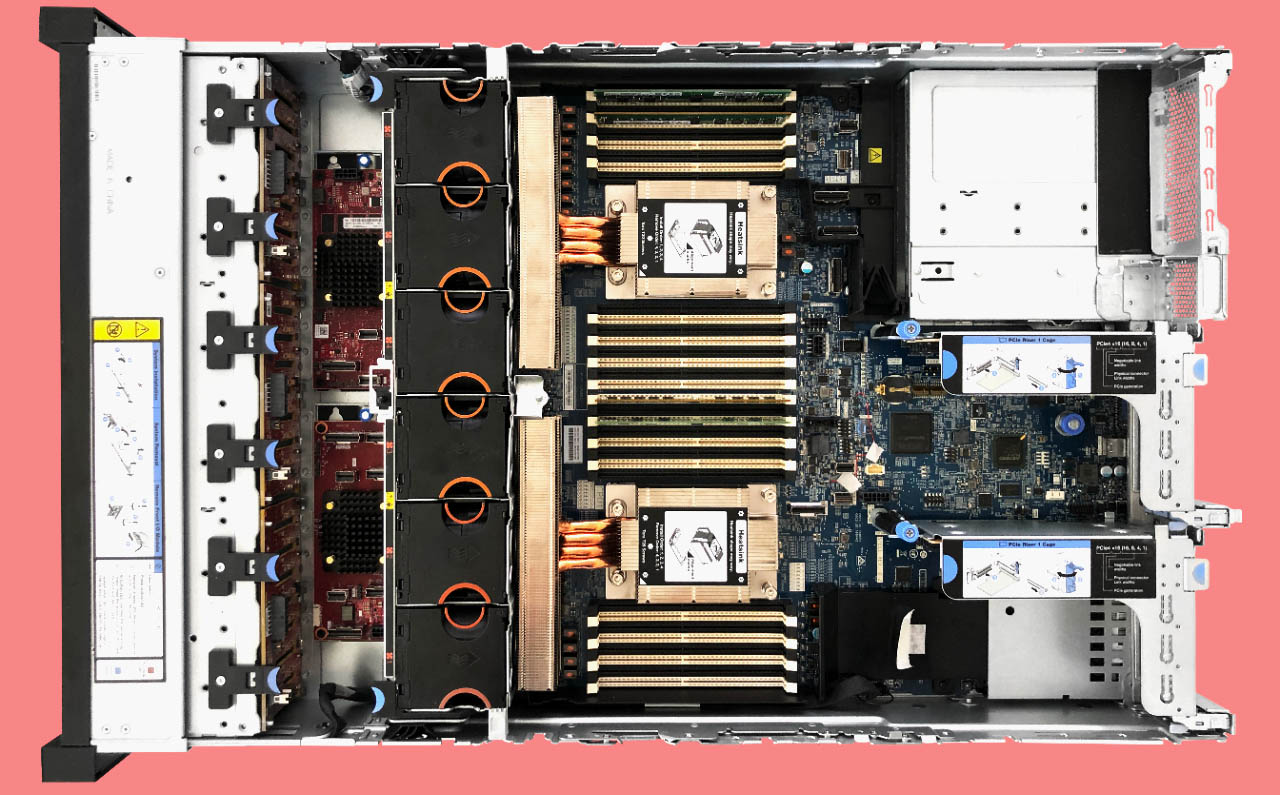
Our astute readers may notice this server shot is a bit strange. There are no motherboard to midplane card cables and no wiring for the front ports present. We think this is more of a demonstration to get the photo during some of the work-from-home times rather than a common configuration.
Lenovo ThinkSystem SR645
The Lenovo ThinkSystem SR645 is the company’s 1U dual-socket offering. This supports up to 3x Tesla T4’s (the SR665 supports up to 8x T4’s) and up to 12x 2.5″ drives (10 can be NVMe.) Lenovo sees this as an important edge analytics box which is why support for the NVIDIA Tesla T4 we reviewed is so important.
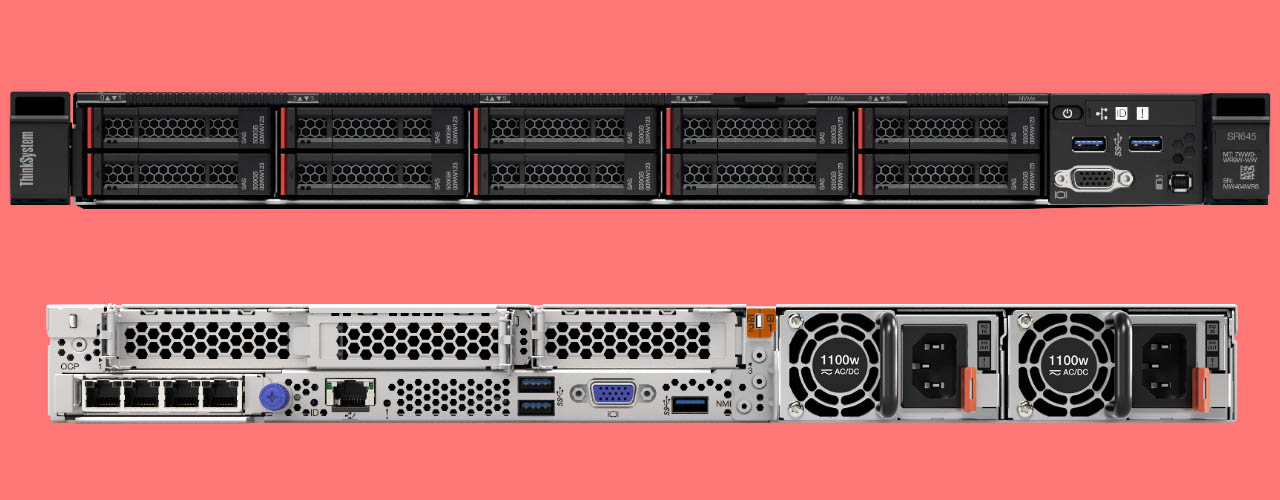
Below are the specs for this machine.
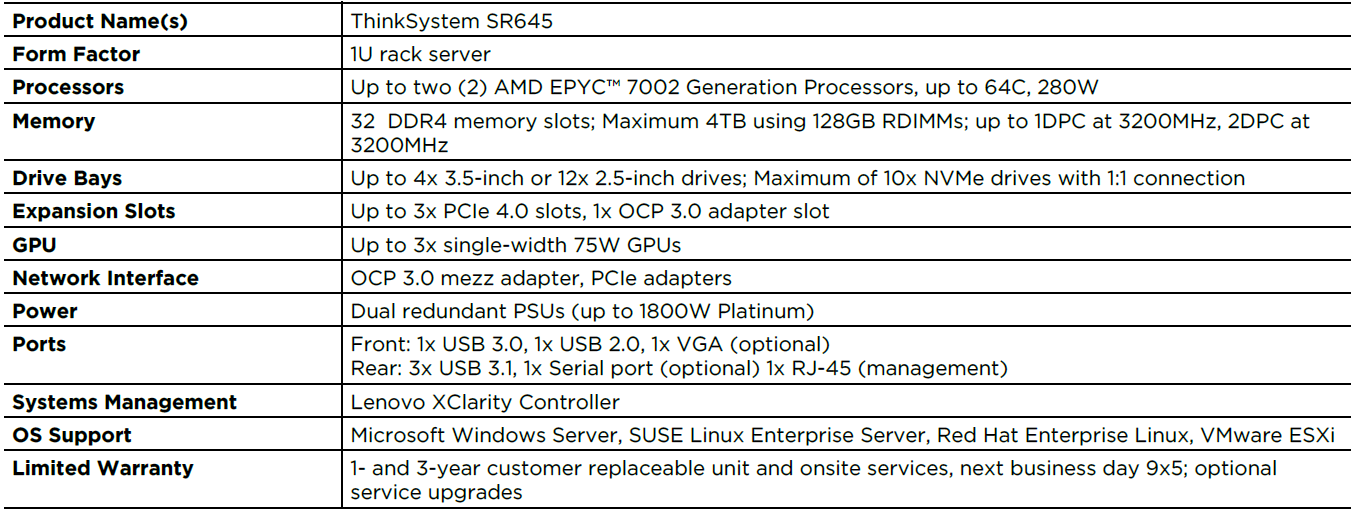
From the internal view, one can see Lenovo is using a common motherboard shared with the ThinkSystem SR665. One can also see the heatsink is a much smaller model. That leads us to believe Lenovo is offering lower and higher-performance cooling options.
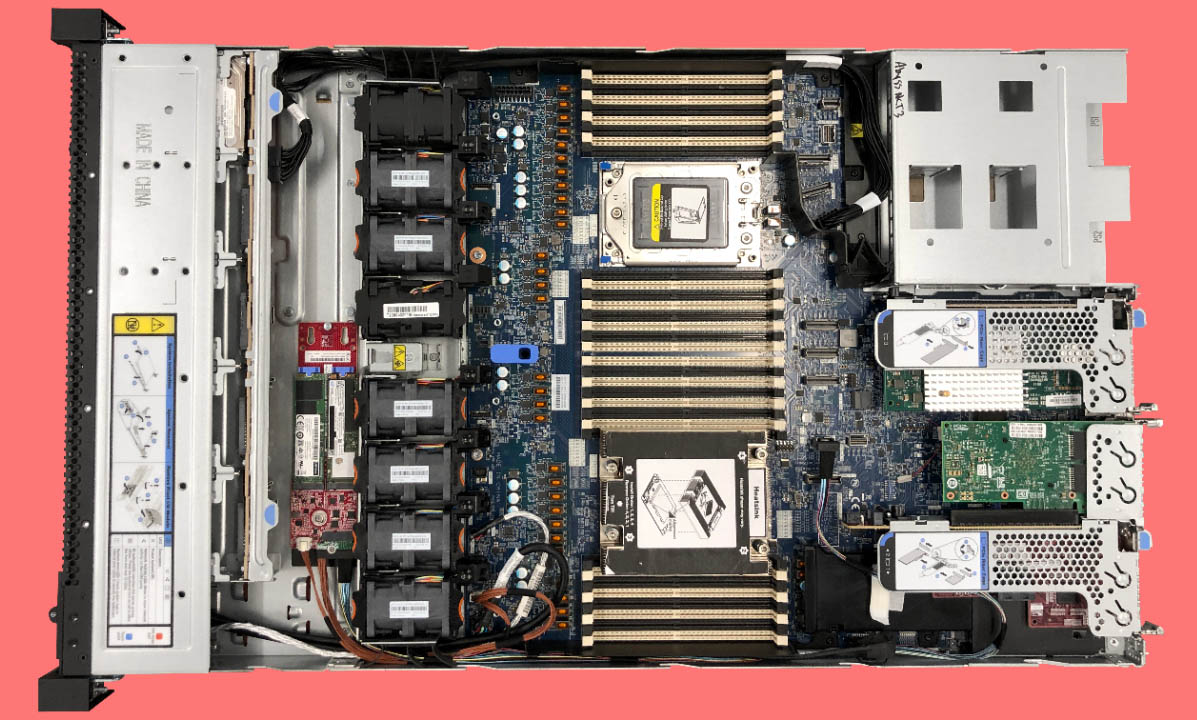
Again, apologies for the harsh lighting here, we are using Lenovo’s photo. A 1U dual 280W server that has the ability to handle accelerators, as well as high-end storage, is a great option.
Final Words
STH asked about the coverage of these solutions compared to the Intel Xeon solutions. Lenovo thinks that the majority of use cases are net-new.
Also, going with our theme of the industry hitting a thermal wall to increasing 2U 4-node density, we asked why we are not seeing a similar solution for Lenovo. Lenovo said the reason that they do not have AMD EPYC 7002 2U 4-node systems like the Gigabyte H262-Z62 and platforms from Dell EMC, HPE, and Supermicro is that Lenovo feels that the 2U 4-node is not a balanced form factor for these chips that have a lot of I/O. The physical size constraints along with the thermal solutions required to support higher-TDP CPUs mean that it feels the 2U 4-node is less practical.
This also seems to be a trend with Lenovo focusing on selling lower-cost servers. The IDC 4Q19 Quarterly Server Tracker showed a surge in Lenovo unit volume with a drastically lower ASP. On one hand, it makes sense that Lenovo would not want to sell higher-density servers that may endanger its volume and ASP mix. At the same time, Lenovo’s current direction for lower-cost nodes seems juxtaposed to the Lenovo ThinkSystem SR665 and SR645 which are going after the higher peripheral count and therefore higher-dollar segments. Perhaps this is a way for Lenovo to claw back its ASP erosion.
Overall, this is another important step. If one wants to see a good indicator of market momentum and also the headwinds new chips like the AMD EPYC face, this is a great case study. It took Lenovo almost ten months since the AMD EPYC 7002 Series Rome Launch to announce mainstream dual-socket servers. That is in the face of Intel Cooper Lake for mainstream 2P servers getting canceled as well.
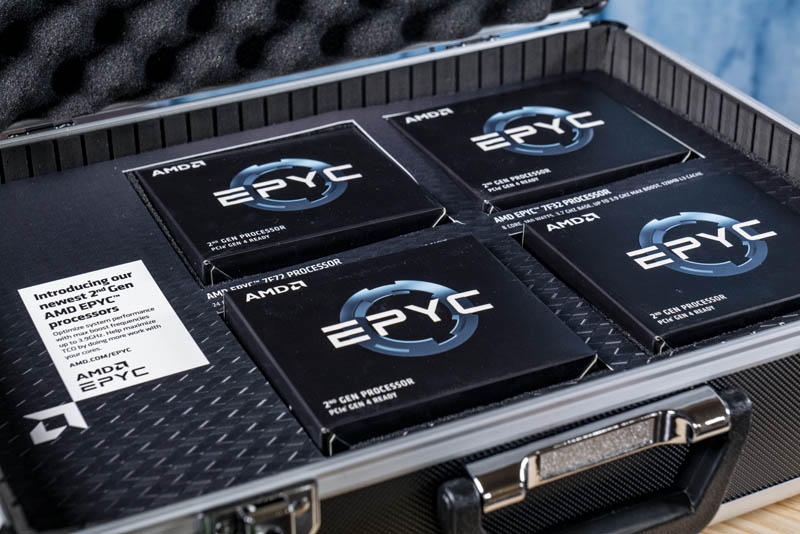
We asked Lenovo, and the company said they are already supporting the EPYC 7Fx2 series “frequency optimized” SKUs that we have been covering in a recent series starting with our AMD EPYC 7F52 benchmarks review, and market perspective piece. With support for up to 280W TDP CPUs, it is fairly clear that Lenovo is planning to support the AMD EPYC 7003 “Milan” CPUs in these servers and potentially even the AMD EPYC 7H12.

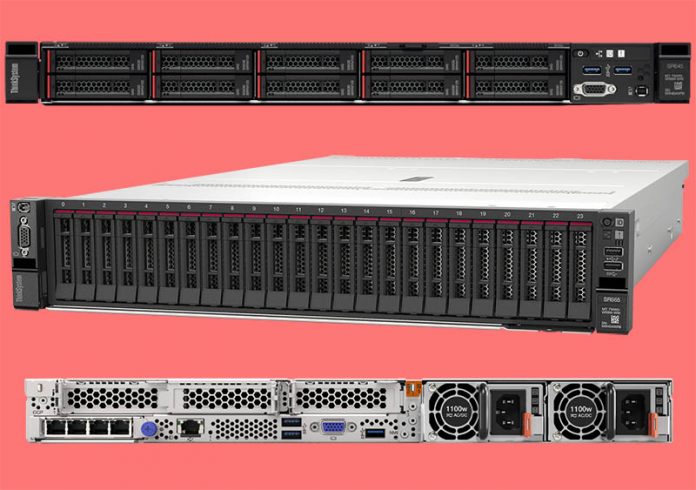



Great that I counted a Supermicro, Inspur, and HPE ad when reading this. That’s good targeting by them.
Let’s see the STH review on these. If we don’t get it, it’s a sign Lenovo doesn’t want them tested thoroughly.
Why didn’t they have you guys review? Pandemic or vaporware?
@Cliff Robinson,
who from Lenovo are you citing for “Lenovo feels that the 2U 4-node is not a balanced form factor for these chips that have a lot of I/O.
The physical size constraints along with the thermal solutions required to support higher-TDP CPUs mean that it feels the 2U 4-node is less practical.”?
Maybe we all will be surprised (again), like we have been by yesterday’s SR645 and SR665 announcement.
The analogy why I think that is, I’ve seen the SR645 and SR665 product guides on Lenovopress.com and it seems that the high TDP CPU options 240W/280W
are supported even along with GPUs. Certain patters of their HPC ‘Neptune’ cooling technology is being applied here. Is this supported in Supermicro,
HPE or Dell EMC 2 socket AMD servers too or in 2U 4-node boxes?
Mike – I can answer that. It was part of my discussion with Kamran Amini, VP and GM of Server, Storage and Software Defined Infrastructure at Lenovo DCG. I asked specifically why we are not seeing mainstream 2U4N platforms from Lenovo, even though Lenovo has them for Intel and many competitors do. I passed the response to Cliff who handles these types of product announcement articles for us.
These are really interesting servers – lots of drive bays, m2 nvme raid boot option, fully supported xclarity. They have big weakness though – they are late.
Is it possible for you to ask why it took so long for Lenovo to bring these servers ?
They were the first with servers that truly supported Rome CPUs.
Moreover it would be great if you could check with them the following:
why they don’t offer Intel NVMe drives with AMD servers
what are their plans for supporting PCIE 4 drives like the ones from Kioxia
do they have any plans for implementing full xclarity support for the sr635 and sr655
Anyway I’m keeping fingers crossed for you getting the chance to tear these servers apart :-)
Stay safe!
Patrick – are you sure the 2U4N server platform is mainstream in Lenovo?
Mike – They have a Xeon ThinkSystem you can easily configure and buy. I am not sure what you mean?